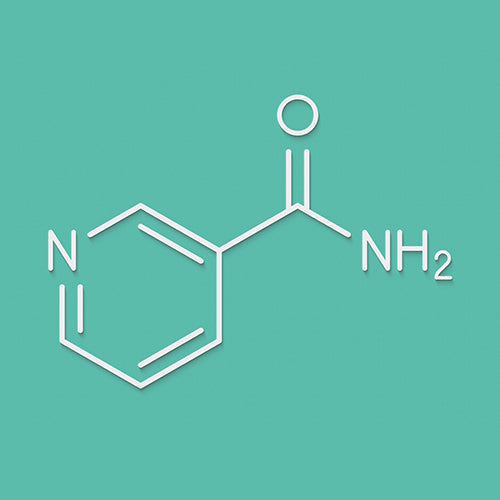If you've paid any attention to skincare over the past decade, you've seen hyaluronic acid everywhere. But hyaluronic acid isn't just for your face. It's been making its way into haircare products too, and your dry, thirsty strands might be wondering what took so long.
We're covering what hyaluronic acid is, what it does for hair and scalp, and its skin benefits too. Also what it can't do—there's a fair bit of overpromising out there.
What is hyaluronic acid?
Hyaluronic acid is a humectant. "What's a humectant?" you ask. It draws water to itself and holds onto it. Your body already makes it—you'll find it in your joints, your eyes, your skin. Anywhere that needs to stay lubricated.
The impressive bit: a single molecule of hyaluronic acid can hold up to 1,000 times its weight in water. That's not marketing speak. It's one of the most effective moisture-binding compounds we know of. Hence why it shows up in pretty much everything with "hydrating" on the label.
On product labels, you might see "sodium hyaluronate" on a product label. Same thing. It's a salt form of hyaluronic acid—more stable in formulations, absorbs well into hair and skin.
Not all hyaluronic acid is sourced the same way, though. Traditionally, it came from rooster combs (yes, really—we weren't thrilled to learn that either). Ours is vegan, produced through bacterial fermentation using plant-based materials. No animal-derived ingredients, no animal testing.
Hyaluronic acid benefits for hair
So what does a skincare darling do for your hair? Quite a bit.
Deep hydration without the weight
Hair gets thirsty. Colour treatments, heat styling, general life—it all takes moisture out. Hyaluronic acid attracts that moisture back and helps your hair hold onto it. Softer, more hydrated, but not heavy or coated.
Fine hair especially. Heavier oils can weigh it down—leave it looking a bit limp. Hyaluronic acid hydrates without that trade-off.
Smoother cuticles, less frizz
Frizz comes down to the cuticle. Lifted cuticles let moisture out and humidity in, which swells the hair shaft. Hyaluronic acid smooths and seals, stabilising moisture levels. Your hair stops reacting to every change in the weather.
High porosity hair—from bleaching, damage, or just how your hair naturally is—will probably notice the biggest difference. Porous hair loses moisture almost as fast as it absorbs it. Hyaluronic acid helps fill in those gaps and keeps hydration where it belongs.
Improved elasticity and hair strength
Well-hydrated hair is more flexible. It bends without snapping. Dry, brittle strands? They break. Keeping moisture in the hair shaft means more elasticity, less breakage over time. Your hairbrush will have less to show for itself.
Scalp health
Healthy hair starts at the scalp. Easy to forget. But if your scalp is dry or flaky, tight and uncomfortable, that shows up in your hair too. Hyaluronic acid hydrates scalp skin the same way it hydrates facial skin, drawing moisture in and helping it stay put. Hydrated scalp, healthier hair. They're connected.
Who benefits most?
Any hair type can benefit from a moisture boost. But you'll probably notice the most dramatic results if your hair is:
-
Dry, damaged, or both
-
Bleached or colour-treated
-
High porosity—absorbs moisture fast but loses it just as fast
-
Frizzy (especially in humidity)
Fine hair benefits too—hyaluronic acid adds hydration without the heaviness that can flatten your hard-won volume.
Our HYDRATING Solid Shampoo and Conditioner pair hyaluronic acid with argan oil and glycerine for a triple-humectant approach. Clinical testing showed an 8x increase in hydration and moisturisation after just one use (compared to damaged hair). That's not a vague "feels softer" claim—it's measurable, and you'll notice.
Our HYDRATING Solid Shampoo and Conditioner pair hyaluronic acid with argan oil and glycerine for a triple-humectant approach. Clinical testing showed an 8x increase in hydration and moisturisation after just one use (compared to damaged hair). That's not a vague "feels softer" claim—it's measurable, and you'll notice.
What about hair growth?
You'll see some claims floating around that hyaluronic acid promotes hair growth. There's limited data linking hyaluronic acid to faster or thicker growth. It's not a treatment for hair loss or thinning hair in the way that something like minoxidil is.
What it does do is support scalp health. Hydrated scalp, better conditions for the hair you're already growing. Think of it as good soil rather than miracle fertiliser—it won't make hair sprout where there isn't any, but it helps what's there thrive.
If you're experiencing significant hair loss, a dermatologist or trichologist is a better starting point than any single ingredient.
Hyaluronic acid benefits for skin
Skin benefits are worth a quick mention too—this is where hyaluronic acid made its name.
The same humectant properties that help hair work beautifully on skin—arguably even better. When applied topically, it draws water into the outer layers of the epidermis. Plumper, more hydrated skin. Fine lines less pronounced. Overall texture improves. Everything looks a bit... dewier.
Peer-reviewed studies back this up. Research published in Dermato-Endocrinology found that hyaluronic acid levels in the skin decrease with age, contributing to visible signs of ageing. Topical application helps replenish what time takes away.
If you're using it on your face: apply to damp skin. It needs moisture available to draw from. It pairs well with occlusives (like oils or heavier creams) that seal the hydration in afterwards. And because your body already produces it naturally, allergic reactions are rare—it's considered safe for most skin types.
Making it work for your hair
Hyaluronic acid isn't a miracle ingredient—nothing is. But it's an effective humectant—helps hair hold moisture, reduces frizz, supports scalp health. And it won't weigh your hair down.
If your hair runs dry or frizzy, worth trying. The HYDRATING Shampoo and Conditioner bars have the clinically proven hydration bit covered—and they outlast bottled equivalents by a fair margin.
References:
-
Papakonstantinou, E., Roth, M., & Karakiulakis, G. (2012). Hyaluronic acid: A key molecule in skin aging. Dermato-endocrinology, 4(3), 253–258.
-
Litwiniuk, M., et al. (2016). Hyaluronic Acid in Inflammation and Tissue Regeneration. Wounds, 28(3), 78–88.

 Impact
Impact Blog
Blog Store Locator
Store Locator


